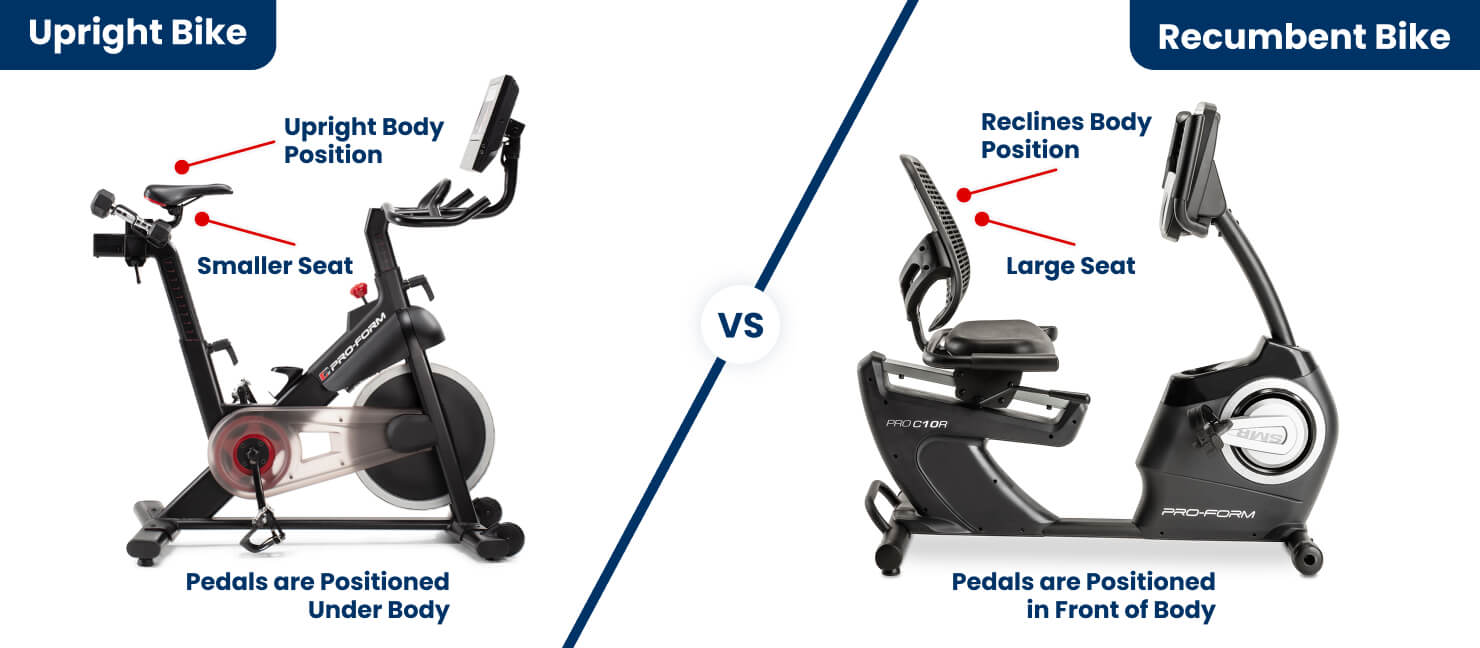
Are you looking to add an indoor bike to your home gym? Knowing the differences between recumbent and upright exercise bikes is important to do before deciding to purchase. In this comparison guide, you’ll learn the differences between recumbent vs upright exercise bikes and figure out which one is better for your workout goals.
Key Takeaways
- Comparing Recumbent Bikes vs Upright Bikes — Both bikes provide cardio training, but recumbent bikes target the lower body while upright bikes target the lower and upper body.
- Exploring Recumbent Exercise Bikes — These bikes provide back support but require more flexion in the hips.
- Understanding Upright Exercise Bikes — These bikes can offer full-body resistance training but require more balance to stay seated on the bike.
- Frequently Asked Questions — Get answers to questions about weight loss, knee pain, workout intensity, and other bike styles.
Comparing Recumbent Bikes vs Upright Bikes
Cycling indoors is an easy way to enjoy bike riding without worrying about weather, terrain, or time of day. Many benefits include improved cardiovascular health, lung capacity, bone density, muscle strength, and weight loss. If you’re looking to work out on an indoor exercise bike, it is helpful to know whether a recumbent or upright exercise bike is better for you. You should consider factors like your:
-
Workout goals
-
Muscle targets
-
Physical limitations
-
Workout space
These factors can all affect whether you choose a recumbent or an upright bike. Both bikes allow you to adjust the seat position and pedal resistance, and some offer training programs to keep you motivated. However, there are quite a few distinctions. The following chart helps break down the differences between the two exercise bikes.
| Recumbent Bikes vs Upright Bikes | ||
|---|---|---|
| Category | Recumbent Bikes | Upright Bikes |
| Muscles Used | Quads, hamstrings, and calves | Quads, hamstrings, calves, glutes, abs, and back muscles |
| Best For | People struggling with balance or recovering from surgery or injury | People who want a more full body, intense workout |
| Body Position | Reclined, closer to the ground | Upright, higher off the ground |
| Leg Position | Extended in front of the body | Beneath the body |
| Seat Size | Larger seat, like a chair | Smaller seat, like a bike saddle |
| Back Support | Full lumbar support, reducing strain on the lower back | No support on most models, requiring more abdominal strength |
| Size of Machine | Heavier, takes up more space | Lighter, takes up less space |
| Joint Comfort | The reclined position puts less strain on the joints | Sitting upright may put more strain on the joints |
| Workout Intensity | Less intense workout suitable for people with mobility issues | More intense workout for people wanting a higher caloric burn |
| Typical Calories Burned | About 400+ calories per hour, depending on intensity | About 500+ calories per hour, depending on intensity |
| Price | On average $200-$1500 | On average $200-$2000 |
Exploring Recumbent Exercise Bikes
Recumbent exercise bikes allow you to exercise while seated in a reclined or leaned-back
position. The word ‘recumbent’ means to lie down. While they do not fully recline,
recumbent bikes provide a more relaxing cardiovascular and lower-body resistance
workout. The seat feels like a comfortable chair with a wide cushion and backrest to
give you full back support.
Although cycling on recumbent bikes is less strenuous
on the joints, pedaling still requires a lot of hip flexion. Make sure you are able to
adjust the seat and resistance level so your hips feel secure and don’t rock back and
forth while pedaling. When your legs are fully extended, you should have a slight bend
in the knees. It is possible to feel discomfort in the hips if using incorrect form or
riding the bike too often.
Who Recumbent Exercise Bikes Are for
Riding a recumbent bike is one of the lowest-impact ways to get your cardiovascular exercise. It will also provide a great leg workout while your upper body takes a break. If you have issues with balance or mobility, need back support, or prefer a hands-free workout to read a book or use your phone, this may be the bike for you!
Recumbent Bike Pros
|
Recumbent Bike Cons
|
Understanding Upright Exercise Bikes
Upright exercise bikes are more like outdoor cruiser bicycles in terms of their shape.
The pedals are below the seat, engaging both your leg and abdominal muscles. Pedaling
this bike requires less flexion in your hip joints than the recumbent style. However,
the seat is smaller and shaped like a bike saddle without a backrest, so you have to
stay balanced to sit upright.
Keep in mind that upright bikes are not the same as
indoor
cycling bikes. Upright bikes keep your torso in a vertical position, rather than
leaning forward over the handlebars. If you are looking for a full-body workout, the
dual-action or fan bike style exercises more of your back and arms.
Who Upright Exercise Bikes Are for
Riding an upright exercise bike is a great way for you to get an indoor riding experience that feels more like a traditional bike. These bikes provide resistance training for both lower and upper-body muscles. If your goal is to have a low-impact but high-intensity cardio workout, this type of bike is a great option for you.
Upright Bike Pros
|
Upright Bike Cons
|

Recapping Recumbent vs. Upright Exercise Bikes
Both recumbent and upright bikes provide a low-impact exercise that improves mobility, strength, and cardiovascular fitness. Recumbent bikes are more comfortable and engage only your lower body. Upright bikes give you more of a full-body workout. For either of the bikes, make sure to test the settings and positioning to make sure you can work out comfortably with the correct form.
Frequently Asked Questions
Q. Are Recumbent or Upright Exercise Bikes Better for Weight Loss?
Exercising with either a recumbent or upright bike can help you burn calories and lose weight. However, riding an upright bike engages more muscle groups, so this style of bike would likely help you burn calories faster.
Q. Are Recumbent or Upright Exercise Bikes Better for Knee Pain?
Both recumbent and upright bikes provide low-impact exercise that is easier on your knees than running or walking. Recumbent bikes are more commonly used for physical therapy post-surgery or ACL recovery. Talk to your primary care provider for a personal recommendation if you are unsure which is best for your needs.
Q. Are Recumbent or Upright Exercise Bikes Better for Intense Workouts?
An upright bike is generally better for more intense workouts because you engage your abdomen and back muscles to sit up. Working more muscle groups will likely increase your heart rate faster, giving you a more difficult cardio workout than riding a recumbent bike.
Q. What are Dual-Action Bikes?
These bikes include mobile handlebars to give you the option of adding upper-body resistance training to your workout. Dual-action bikes are available at Academy in the upright and recumbent styles. Most upright models include a pedal-powered fan to keep you cool.
Q. Are there Other Types of Indoor Bikes?
Yes! If you would like to compare all of the indoor bike styles available at Academy, you can find more information in our article, 7 Types of Exercise Bikes to Help You Reach Your Fitness Goals.
Have Fun Out There!
Now that you know the differences between recumbent and upright exercise bikes, you can choose the best type to add to your home gym. Academy Sports + Outdoors has a wide variety of recumbent and upright exercise bikes for you to choose from. Shop online or in-store today to start your home exercise journey.


